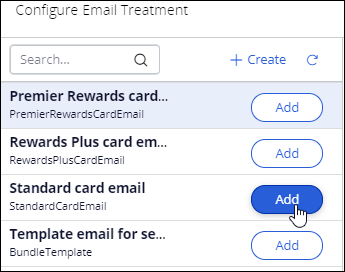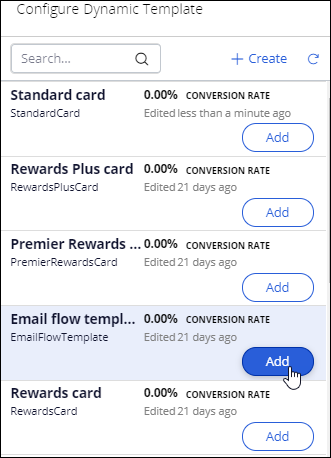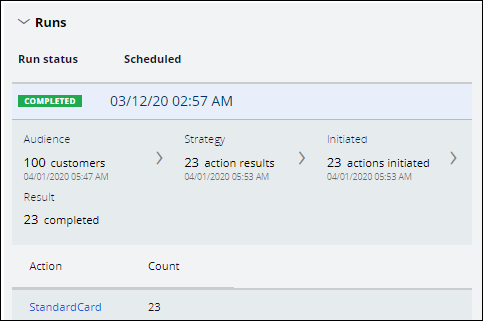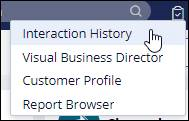
Sending offer emails
4 Tasks
20 mins
Scenario
U+ Bank has recently implemented a project in which credit card offers are presented to qualified customers when they log in to the web self-service portal.
The bank now wants to promote the same offers through email. They want to send the email message to qualified customers. The bank wants to promote only the Standard credit card on the email channel to start.
In preparation, a consultant has already created the Standard Card action, email treatment and action flow.
You are now expected to make the remaining configurations in Pega Customer Decision Hub™ to present the Standard credit card offer to all qualified customers.
Use the following credentials to log in to the exercise system:
|
Role |
User name |
Password |
|
Decisioning Analyst |
CDHAnalyst |
rules |
Your assignment consists of the following tasks:
Task 1: Add email treatment to the Standard card action
Configure the Standard card action to add the email channel with an email template, Standard card Email.
Task 2: Configure the Standard card action flow
Configure the Standard card action flow to use the dynamic template, Email flow template.
Task 3: Enable the Email channel and configure a scheduled run
In the Next-Best-Action Designer > Channels tab, enable the Email channel and configure a scheduled run.
Task 4: Confirm that the customers receive the promotional email
Confirm that the customers receive the promotional email for the Standard card action. Also, verify that the click-through link takes the customer to the Credit Cards landing page.
Challenge Walkthrough
Detailed Tasks
1 Add email treatment to the Standard card action
- Log in as Decisioning Analyst with user name CDHAnalyst and password rules.
- In Next-Best-Action Designer, click Engagement policy.
- In the Business structure section, click CreditCards.
- In the Offers area, click Standard card to open the offer details.
- In the Standard card details, click Check out to make changes.
- Click the Treatments tab to view existing treatments for this action and configure new treatments.
- On the Treatments tab, click Add channel > Email to add a new email treatment.
- In the Configure Email Treatment window, to the right of Standard card email, click Add to add the treatment to the action.
- Click Apply to confirm the treatment selection and close the window. The treatment is now added to the action.
2 Configure the Standard card action flow
- In the Standard card details, click the Flow tab.
- To the right of Dynamic template, click None to configure an existing flow template.
- In the Configure Dynamic Template window, to the right of Email flow template, click Add to add the flow template to the action.
- Click Apply to confirm the flow selection and close the window. The action flow is now added to the action.
- Click Check in to save the changes and provide a suitable check-in comment when prompted (for example: Action flow configured).
- Close the Standard card details.
3 Enable the Email channel and configure a schedule run
- In Next-Best-Action Designer, click Channels.
- Click Edit to make changes.
- Turn on the Email switch.
- Scroll down. In the Primary Schedule section, in the Recurrence area, click the Gear icon to schedule run frequency.
- In the Configure outbound schedule window, ensure that today’s date is populated as the Start Date and that the time is current and in the US Eastern Standard Time (EST) time zone.
- Select the Refresh the audience check box to ensure that the latest customer information is always used when running the schedule.
- Click Submit.
- In the Starting population area, click the Gear icon to select the customers who are qualified to receive the outbound message.
- In the Configure Audience window, to the right of All mailable customers, click Add to add the segment.
- Click Apply to confirm the segment selection and close the window.
- Click Save to save the changes made to Channels.
- In the Primary Schedule section, click the More icon (three dots), and then select Run to run the outbound schedule.
Note: The status changes to Running when it starts processing. An entry for upcoming runs appears in the Run Schedule section.
- Refresh the tab to see the latest status of the run.
- Once the run is complete, click Complete run status to view the results.
Note: Your run results number might not match the numbers shown in the exercise steps as the segment used in the exercise system selects a random sample of 100 customers in each run.
4 Confirm that the customers receive the promotional email
- In the browser tab where you accessed your Pega Academy exercise system, click Email.
- Access the mailbox and open emails to record impressions to simulate customer behavior.
- In the email message, click APPLY TODAY to record clicks and simulate positive customer behavior.
- Log in to Customer Decision Hub.
- In the header, click Reports, and then select Interaction History.
- Click the Recent Interactions tab.
- Notice the recorded outcomes.
Available in the following mission:
If you are having problems with your training, please review the Pega Academy Support FAQs.
Want to help us improve this content?













